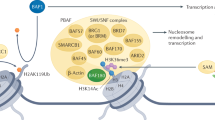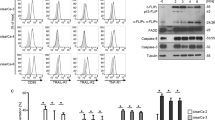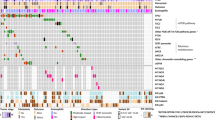Abstract
Renal cell carcinoma (RCC) is resistant to chemotherapy, and this resistance is mirrored by a high apoptosis resistance of many RCC lines in vitro. Here, we report the loss of the pro-apoptotic BH3-only protein Bim in a large part of clinical RCC cases and provide evidence for a functional relevance of this loss. Immunohistochemistry of clear cell renal cell carcinoma cases and corresponding normal kidney showed strong Bim reactivity in renal tubules of all cases but loss of Bim in 35 of 45 RCC samples. Out of nine RCC cell lines investigated, six showed strongly diminished or undetectable levels of Bim protein by western blotting. Four RCC lines of varying apoptosis sensitivity were analysed further. Bcl-2, Bcl-xL, Mcl-1, Bax and Bak expression did not correlate with apoptosis sensitivity. All cell lines underwent apoptosis upon forced expression of Bax and Bim, suggesting an upstream difference. In all four lines, adriamycin induced p53 but not its targets Puma or Noxa. However, apoptosis sensitivity correlated with levels of Bim protein. Bim siRNA reduced apoptosis sensitivity in a susceptible cell line. Furthermore, inhibition of histone deacetylation restored Bim expression in cell lines. These data suggest that Bim has a function as a tumor suppressor in RCC.
This is a preview of subscription content, access via your institution
Access options
Subscribe to this journal
Receive 50 print issues and online access
$259.00 per year
only $5.18 per issue
Buy this article
- Purchase on Springer Link
- Instant access to full article PDF
Prices may be subject to local taxes which are calculated during checkout








Similar content being viewed by others
Abbreviations
- CCRCC:
-
clear cell renal cell carcinoma
- HDAC:
-
histone deacetylase
- RCC:
-
renal cell carcinoma
- TSA:
-
trichostatin A
References
Adams JM, Cory S . (2001). Life-or-death decisions by the Bcl-2 protein family. Trends Biochem Sci 26: 61–66.
Bird AP, Wolffe AP . (1999). Methylation-induced repression – belts, braces, and chromatin. Cell 99: 451–454.
Bouillet P, Metcalf D, Huang DC, Tarlinton DM, Kay TW, Kontgen F et al. (1999). Proapoptotic Bcl-2 relative Bim required for certain apoptotic responses, leukocyte homeostasis, and to preclude autoimmunity. Science 286: 1735–1738.
Chen L, Willis SN, Wei A, Smith BJ, Fletcher JI, Hinds MG et al. (2005). Differential targeting of prosurvival Bcl-2 proteins by their BH3-only ligands allows complementary apoptotic function. Mol Cell 17: 393–403.
Coultas L, Bouillet P, Loveland KL, Meachem S, Perlman H, Adams JM et al. (2005). Concomitant loss of proapoptotic BH3-only Bcl-2 antagonists Bik and Bim arrests spermatogenesis. EMBO J 24: 3963–3973.
Coultas L, Bouillet P, Stanley EG, Brodnicki TC, Adams JM, Strasser A . (2004). Proapoptotic BH3-only Bcl-2 family member Bik/Blk/Nbk is expressed in hemopoietic and endothelial cells but is redundant for their programmed death. Mol Cell Biol 24: 1570–1581.
Daniel PT, Pun KT, Ritschel S, Sturm I, Holler J, Dorken B et al. (1999). Expression of the death gene Bik/Nbk promotes sensitivity to drug-induced apoptosis in corticosteroid-resistant T-cell lymphoma and prevents tumor growth in severe combined immunodeficient mice. Blood 94: 1100–1107.
Debatin KM, Poncet D, Kroemer G . (2002). Chemotherapy: targeting the mitochondrial cell death pathway. Oncogene 21: 8786–8803.
Dijkers PF, Medema RH, Lammers JW, Koenderman L, Coffer PJ . (2000). Expression of the pro-apoptotic Bcl-2 family member Bim is regulated by the forkhead transcription factor FKHR-L1. Curr Biol 10: 1201–1204.
Earnshaw WC, Martins LM, Kaufmann SH . (1999). Mammalian caspases: structure, activation, substrates, and functions during apoptosis. Annu Rev Biochem 68: 383–424.
Egle A, Harris AW, Bouillet P, Cory S . (2004). Bim is a suppressor of Myc-induced mouse B cell leukemia. Proc Natl Acad Sci USA 101: 6164–6169.
Fischer SF, Schwarz C, Vier J, Hacker G . (2001). Characterization of antiapoptotic activities of Chlamydia pneumoniae in human cells. Infect Immun 69: 7121–7129.
Fischer SF, Vier J, Kirschnek S, Klos A, Hess S, Ying S et al. (2004). Chlamydia inhibit host cell apoptosis by degradation of proapoptotic BH3-only proteins. J Exp Med 200: 905–916.
Gerhard MC, Zantl N, Weirich G, Schliep S, Seiffert B, Hacker G . (2003). Functional evaluation of the apoptosome in renal cell carcinoma. Br J Cancer 89: 2147–2154.
Gillissen B, Essmann F, Graupner V, Starck L, Radetzki S, Dorken B et al. (2003). Induction of cell death by the BH3-only Bcl-2 homolog Nbk/Bik is mediated by an entirely Bax-dependent mitochondrial pathway. EMBO J 22: 3580–3590.
Green DR, Evan GI . (2002). A matter of life and death. Cancer Cell 1: 19–30.
Green DR, Reed JC . (1998). Mitochondria and apoptosis. Science 281: 1309–1312.
Gurova KV, Hill JE, Guo C, Prokvolit A, Burdelya LG, Samoylova E et al. (2005). Small molecules that reactivate p53 in renal cell carcinoma reveal a NF-kappaB-dependent mechanism of p53 suppression in tumors. Proc Natl Acad Sci USA 102: 17448–17453.
Gurova KV, Hill JE, Razorenova OV, Chumakov PM, Gudkov AV . (2004). p53 pathway in renal cell carcinoma is repressed by a dominant mechanism. Cancer Res 64: 1951–1958.
Han J, Flemington C, Houghton AB, Gu Z, Zambetti GP, Lutz RJ et al. (2001). Expression of bbc3, a pro-apoptotic BH3-only gene, is regulated by diverse cell death and survival signals. Proc Natl Acad Sci USA 98: 11318–11323.
Hanahan D, Weinberg RA . (2000). The hallmarks of cancer. Cell 100: 57–70.
Hengartner MO . (2000). The biochemistry of apoptosis. Nature 407: 770–776.
Huang A, Fone PD, Gandour-Edwards R, White RW, Low RK . (1999). Immunohistochemical analysis of BCL-2 protein expression in renal cell carcinoma. J Urol 162: 610–613.
Janzen NK, Kim HL, Figlin RA, Belldegrun AS . (2003). Surveillance after radical or partial nephrectomy for localized renal cell carcinoma and management of recurrent disease. Urol Clin North Am 30: 843–852.
Jeffers JR, Parganas E, Lee Y, Yang C, Wang J, Brennan J et al. (2003). Puma is an essential mediator of p53-dependent and -independent apoptotic pathways. Cancer Cell 4: 321–328.
Kallio JP, Hirvikoski P, Helin H, Luukkaala T, Tammela TL, Kellokumpu-Lehtinen P et al. (2004). Renal cell carcinoma Mib-1, Bax and Bcl-2 expression and prognosis. J Urol 172: 2158–2161.
Kane RC, Farrell AT, Saber H, Tang S, Williams G, Jee JM et al. (2006). Sorafenib for the treatment of advanced renal cell carcinoma. Clin Cancer Res 12: 7271–7278.
Kim H, Rafiuddin-Shah M, Tu HC, Jeffers JR, Zambetti GP, Hsieh JJ et al. (2006). Hierarchical regulation of mitochondrion-dependent apoptosis by BCL-2 subfamilies. Nat Cell Biol 8: 1348–1358.
Kolenko V, Uzzo RG, Bukowski R, Bander NH, Novick AC, Hsi ED et al. (1999). Dead or dying: necrosis versus apoptosis in caspase-deficient human renal cell carcinoma. Cancer Res 59: 2838–2842.
Kuwana T, Bouchier-Hayes L, Chipuk JE, Bonzon C, Sullivan BA, Green DR et al. (2005). BH3 domains of BH3-only proteins differentially regulate Bax-mediated mitochondrial membrane permeabilization both directly and indirectly. Mol Cell 17: 525–535.
Kuwana T, Mackey MR, Perkins G, Ellisman MH, Latterich M, Schneiter R et al. (2002). Bid, bax, and lipids cooperate to form supramolecular openings in the outer mitochondrial membrane. Cell 111: 331–342.
Labi V, Erlacher M, Kiessling S, Villunger A . (2006). BH3-only proteins in cell death initiation, malignant disease and anticancer therapy. Cell Death Differ 13: 1325–1338.
Letai A, Bassik MC, Walensky LD, Sorcinelli MD, Weiler S, Korsmeyer SJ . (2002). Distinct BH3 domains either sensitize or activate mitochondrial apoptosis, serving as prototype cancer therapeutics. Cancer Cell 2: 183–192.
Mickisch GH . (2002). Principles of nephrectomy for malignant disease. BJU Int 89: 488–495.
Motzer RJ, Hutson TE, Tomczak P, Michaelson MD, Bukowski RM, Rixe O et al. (2007). Sunitinib versus interferon alfa in metastatic renal-cell carcinoma. N Engl J Med 356: 115–124.
Nakano K, Vousden KH . (2001). PUMA, a novel proapoptotic gene, is induced by p53. Mol Cell 7: 683–694.
O'Connor L, Strasser A, O'Reilly LA, Hausmann G, Adams JM, Cory S et al. (1998). Bim: a novel member of the Bcl-2 family that promotes apoptosis. EMBO J 17: 384–395.
O'Reilly LA, Cullen L, Visvader J, Lindeman GJ, Print C, Bath ML et al. (2000). The proapoptotic BH3-only protein bim is expressed in hematopoietic, epithelial, neuronal, and germ cells. Am J Pathol 157: 449–461.
Oda E, Ohki R, Murasawa H, Nemoto J, Shibue T, Yamashita T et al. (2000). Noxa, a BH3-only member of the Bcl-2 family and candidate mediator of p53-induced apoptosis. Science 288: 1053–1058.
Phillips JL, Ghadimi BM, Wangsa D, Padilla-Nash H, Worrell R, Hewitt S et al. (2001). Molecular cytogenetic characterization of early and late renal cell carcinomas in von Hippel–Lindau disease. Genes Chromosomes Cancer 31: 1–9.
Putcha GV, Moulder KL, Golden JP, Bouillet P, Adams JA, Strasser A et al. (2001). Induction of BIM, a proapoptotic BH3-only BCL-2 family member, is critical for neuronal apoptosis. Neuron 29: 615–628.
Puthalakath H, Huang DC, O'Reilly LA, King SM, Strasser A . (1999). The proapoptotic activity of the Bcl-2 family member Bim is regulated by interaction with the dynein motor complex. Mol Cell 3: 287–296.
Puthalakath H, Strasser A . (2002). Keeping killers on a tight leash: transcriptional and post-translational control of the pro-apoptotic activity of BH3-only proteins. Cell Death Differ 9: 505–512.
Salvesen GS, Dixit VM . (1997). Caspases: intracellular signaling by proteolysis. Cell 91: 443–446.
Sturm I, Stephan C, Gillissen B, Siebert R, Janz M, Radetzki S et al. (2006). Loss of the tissue-specific proapoptotic BH3-only protein Nbk/Bik is a unifying feature of renal cell carcinoma. Cell Death Differ 13: 619–627.
Tan TT, Degenhardt K, Nelson DA, Beaudoin B, Nieves-Neira W, Bouillet P et al. (2005). Key roles of BIM-driven apoptosis in epithelial tumors and rational chemotherapy. Cancer Cell 7: 227–238.
Vaux DL, Hacker G, Strasser A . (1994). An evolutionary perspective on apoptosis. Cell 76: 777–779.
Villunger A, Michalak EM, Coultas L, Mullauer F, Bock G, Ausserlechner MJ et al. (2003). p53- and drug-induced apoptotic responses mediated by BH3-only proteins Puma and Noxa. Science 302: 1036–1038.
Wang X . (2001). The expanding role of mitochondria in apoptosis. Genes Dev 15: 2922–2933.
Wei MC, Zong WX, Cheng EH, Lindsten T, Panoutsakopoulou V, Ross AJ et al. (2001). Proapoptotic BAX and BAK: a requisite gateway to mitochondrial dysfunction and death. Science 292: 727–730.
Whitfield J, Neame SJ, Paquet L, Bernard O, Ham J . (2001). Dominant-negative c-Jun promotes neuronal survival by reducing BIM expression and inhibiting mitochondrial cytochrome c release. Neuron 29: 629–643.
Willis SN, Chen L, Dewson G, Wei A, Naik E, Fletcher JI et al. (2005). Proapoptotic Bak is sequestered by Mcl-1 and Bcl-xL, but not Bcl-2, until displaced by BH3-only proteins. Genes Dev 19: 1294–1305.
Zhu Y, Swanson BJ, Wang M, Hildeman DA, Schaefer BC, Liu X et al. (2004). Constitutive association of the proapoptotic protein Bim with Bcl-2-related proteins on mitochondria in T cells. Proc Natl Acad Sci USA 101: 7681–7686.
Acknowledgements
We thank Christina Hilpert, Antje and Anja Richter for expert technical assistance. This work was supported by the Deutsche Krebshilfe (grant 10-1923 to NZ and GH).
Author information
Authors and Affiliations
Corresponding author
Additional information
Supplementary Information accompanies the paper on the Oncogene website (http://www.nature.com/onc).
Supplementary information
Rights and permissions
About this article
Cite this article
Zantl, N., Weirich, G., Zall, H. et al. Frequent loss of expression of the pro-apoptotic protein Bim in renal cell carcinoma: evidence for contribution to apoptosis resistance. Oncogene 26, 7038–7048 (2007). https://doi.org/10.1038/sj.onc.1210510
Received:
Revised:
Accepted:
Published:
Issue Date:
DOI: https://doi.org/10.1038/sj.onc.1210510
Keywords
This article is cited by
-
BCL-2 protein family: attractive targets for cancer therapy
Apoptosis (2023)
-
T-cell receptor signal strength and epigenetic control of Bim predict memory CD8+ T-cell fate
Cell Death & Differentiation (2020)
-
The role of apoptosis repressor with a CARD domain (ARC) in the therapeutic resistance of renal cell carcinoma (RCC): the crucial role of ARC in the inhibition of extrinsic and intrinsic apoptotic signalling
Cell Communication and Signaling (2017)
-
Pro-apoptotic Bim suppresses breast tumor cell metastasis and is a target gene of SNAI2
Oncogene (2015)
-
Biomarker in Nierenzellkarzinomen
Der Pathologe (2015)



